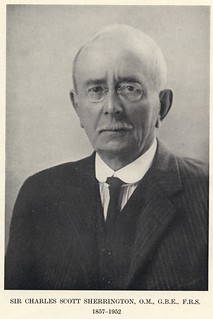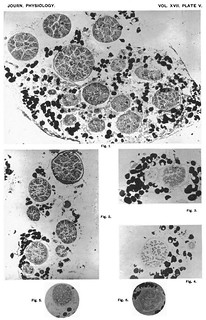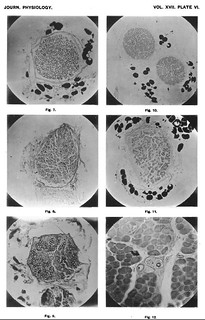- Creation
-
Creators (Definite): Sir Charles Scott Sherrington; Albert Frank Stanley KentDate: 1894
- Current Holder(s)
-
- No links match your filters. Clear Filters
-
Cited by
 C.S. Sherrington, 'On the Anatomical Constitution of Nerves of Skeletal Muscles; with Remarks on Recurrent Fibres in the Ventral Spinal Nerve-root', Journal of Physiology 17 (3-4) (1894), pp. 210-258.
C.S. Sherrington, 'On the Anatomical Constitution of Nerves of Skeletal Muscles; with Remarks on Recurrent Fibres in the Ventral Spinal Nerve-root', Journal of Physiology 17 (3-4) (1894), pp. 210-258.
Description:Explanation of Plate VII (figs. 13-18):
'Fig. 13. Gracilis muscle, Monkey; root-ganglion fibres only remaining. Muscle-spindle containing eight muscle-fibres: near it a "spindle nerve" containing five large myelinate fibres; also a motor nerve from which all nyelinate fibres have disappeared. The periaxial space is well seen.
Fig. 14. Adductor hallucis muscle (Monkey). 6th, 7th, 8th and 9th post-thoracic ventral and dorsal spinal roots severed, the latter proximal to ganglia. Fifty days degeneration allowed. A compound "muscle-spindle" in cross section near one of its poles. Three large muscle-fibres and five small inside the spindle. A large thinly myelinate nerve-fibre is seen cut twice, obliquely, in the capsule of the organ.
Fig. 15. Vastus medialis muscle (Cat). 4th, 5th, 6th and 7th postthoracic ventral and dorsal spinal roots severed, the latter proximal to ganglia. Sixty days degeneration allowed. Muscle-spindle through its proximal polar region containing three large and six small muscle fibres. A large root-ganglion fibre lies in the outer part of the capsule of the organ, a smaller myeliniate fibre lies close to the muscle-fibres in the core of the organ.
Fig. 16. Biceps femoris (Cat). 6th, 7th, 8th and 9th post-thoracic ventral and dorsal spinal roots cut, latter proximal to ganglion. 106 days degeneration allowed. A "muscle-spindle" in cross section through its equatorial region. Three thinly myelinate nerve-fibres obliquely cut in the periaxial space. Nine muscle-fibres and two non-myelinate terminal nerve fibres seen in core. The delicate tissue in the periaxial lymph space is visible.
Fig. 17. Semimembranosus muscle (Monkey). 6th, 7th, 8th and 9th post-thoracic ventral and dorsal spinal roots severed, latter proximal to ganglia. Fifty days degeneration allowed. A "muscle-spindle" in cross section through the equatorial region. Two myelinate fibres cut obliquely in the thickness of the capsule of the spindle; three cut fairly transversely just within the periaxial lymph-space. Six muscle-fibres and two non-myelinate nerve-fibres cut transversely within the core of the organ.
Fig. 18. Interosseous plantar muscle (Cat). Compound "muscle-spindle" in distal polar region not far from junction with equatorial region. One division of the spindle contains eight muscle-fibres, the other nine muscle fibres. In the smaller division a myelinate fibre is seen in transverse section, in the larger a myelinate fibre curves across from the centre to the periphery of the intrafusal bundle. At one side of the spindle lies a large solitary "spindle" nerve-fibre enclosed in a well-developed loosely-fitting sheath of Henle.' (257-258)
Fig. 13 in text:
'besides isolated nerve-fibres attaining the spindles, not infreqtient are small nerve twigs conisisting of 3-6 large spinal-ganglion fibres all bound for one and the same muscle-spindle and entering it at one point, or two closely adjacent points. These twigs are pure spindle-nerves. Such spindle-nerves form one class of the purely afferent intramuscular nerve-trunks above described. One such is figured in Fig. 13, Plate VII.' (244)
Figs 16-17 in text:
'These septa, as also the membranes of the capsule proper, are studded with sparse oval nuclei like those upon the coats of a Pacinian corpuscle. The open work of delicate septa webbing across the periaxial lymph space fuses on one side with the inner face of the inmost sheet of the corpuscle proper, on the other with a thin more or less perfect layer of connective tissue which immediately invests the axial core of the spinidle. This investment I would term the axial sheath. It is fairly well shown in figs. 16 and 17, Plate VII. It is richly nucleate and supports as well as invests the neuro-muscular contents of the organ. In a compound spindle each intrafusal muscle-bundle retains its own axial sheath, even where the capsules of the component spindles are completely merged one in another.' (240-241)
Fig. 16 in text:
'In the equatorial region the intrafusal muscle-fibre often becomes somewhat smaller in diameter and is nearly always circular in section. Its surface zone soon gets thickly encrusted with or almost completely occupied by a sheet of nuclei. Whether these nuclei are strictly part of the muscle-fibre proper is not clear to me. The nuclei are spherical or slightly oval, are clear, and measure about 6µ diameter. Cross-sections reveal beneath the nuclear sheet a thin tuibular layer which is fibrillated. This tubular layer itself invests a central core (4µ-5µ) of hyaline substance, which runs rodlike along the axis of the intrafusal fibre in this region (Fig. 16). The cross-section of the fibre thus often displays a nearly complete zone of four to six nuclei around a hyaline centre. The striation is obscured by the nuclei clothing the face of the attenuated fibre, but where seen in the adjoining regions the striation is very marked, and coarser than in the ordinary muscle-fibres outside the spindle.' (242)
'The equatorial region usually occupies somewhat less than one-third of the entire length of the spindle (Fig. 16, Plate VII.). On emerging from this region the intrafusal fibres quickly regain the character they possess in the proximal polar region. The number of nuclei in them becomes less as the distal pole of the spindle is approached.' (243)
-
Cited by
 T. Quick, 'Disciplining Physiological Psychology: Cinematographs as Epistemic Devices, 1897-1922', Science in Context 30 (4), pp. 423-474.
T. Quick, 'Disciplining Physiological Psychology: Cinematographs as Epistemic Devices, 1897-1922', Science in Context 30 (4), pp. 423-474.
Description:'the mode in which Sherrington presented his work owed as much to the formulae, tables and calculations of the Cavendish physicists as it did to the anatomic accuracy of his Cambridge mentors. Rather than present lavish illustrations of his nerve investigations, as had Gaskell, Sherrington supplied tables of response measurements, graphs of reaction-intensities, and introduced grids with which he might reduce the complexity of nervous anatomy (fig. 1). His study addressing the pioneering histological work of Angelo Ruffini replaced the latter's all-encompassing hand-drawn delineations with a series of microphotographs (fig. 2).'
'Figs. 1 (left) and 2 (right): Left: part of plate XIV from C.S. Sherrington, 'Note on the Spinal Portion of some Ascending Degenerations', Journal of Physiology 14 (4-5) (1893), pp. 255-302. Right: plate VII from C.S. Sherrington, 'On the Anatomical Constitution of Nerves of Skeletal Muscles; with Remarks on Recurrent Fibres in the Ventral Spinal Nerve-Root', Journal of Physiology 17 (3-4) (1894), pp. 210-254.'









